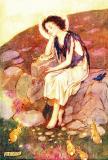Cuthbert
(Cuthbert of Lindisfarne)
634–687
 |
Cuthbert was a Northumbrian lad who joined the monastery at Melrose at age seventeen after seeing a vision of St. Aidan while watching sheep. He resided in the monastery for a short time but left to serve the King of Northumbria in a long running series of battles with the Kingdom of Mercia. He is known to have fought at the Battle of Winwidfield but returned to the monastery after completing his military service. During this time bishops from both the Roman and Celtic churches were working to resolve their differences. In 664 a Synod was called, an agreement was reached, and Cuthbert was appointed Prior of Melrose in order to help the Celtic monastery convert to Roman usages. His success at Melrose inspired the bishop to appoint him to be prior at Lindisfarne, the most important Abbey in the region and a bastion of Celtic chauvinism. Cuthbert's excellent reputation proceeded him and with great tact and patience he succeeded well in his task.
After ten years at Lindisfarne, Cuthbert sought greater solitude and removed himself to an uninhabited island nearby where he lived in great austerity. His voluntary removal from all the comforts and temptations of civilization only enhanced his already widely acclaimed reputation as a holy man. Eventually however, he was recalled to Lindisfarne to serve as bishop and died shortly thereafter.
Key events during the life of Saint Cuthbert of Lindisfarne:
| St. Cuthbert born in Northumbria. | |
| St. Aidan becomes first bishop of Lindisfarne. | |
| Battle of Maserfield: Northumbrians defeat Mercians. | |
| Vision while watching sheep caused Cuthbert seek for the monastic life at Melrose. | |
| Fought in battle of Winwidfield, then returned to monastery. | |
| Attended Synod of Whitby, which ruled that Celtic church would adopt Roman rites. | |
| Became prior of Melrose | |
| Sent to Lindisfarne, to help convert the Celtic monastery to roman usages. | |
| Retired to seclusion on Farne island. | |
| Appointed bishop of Lindisfarne | |
| Returned to Farne island to die. |
Other Resources
| Saint Cuthbert's Peace in | The Book of Saints and Friendly Beasts by Abbie Farwell Brown |
| Apostle of Northumbria in | The Book of Saints and Heroes by Mrs. Lang |
| Story of Saint Cuthbert in | Saint Christopher and Saint Cuthbert by Mary Macgregor |
| Saint Cuthbert in | Our Island Saints by Amy Steedman |
Image Links | ||
|---|---|---|
 The man on the White Horse comes to heal St. Cuthbert.' in The Book of Saints and Heroes |
 Why have you not given our handmaid her share?' in The Book of Saints and Heroes |
 How the horse sympathised with St. Columba in The Book of Saints and Heroes |
 Saint Cuthbert entertains an angel in the disguise of a pilgrim in Saint Christopher and Saint Cuthbert |
 It was the little grey road beneath on which his eyes were fixed in Our Island Saints |
|
| Caedmon | Earliest known Anglo-Saxon poet. His story was related by St. Bede. |
| St. Aiden | First Bishop of Lindisfarne. |
| Penda | King of Mercia who warred with the Northumbrians. |
| Edwin of Northumbria | King of Northumbria who converted to Christianity. |